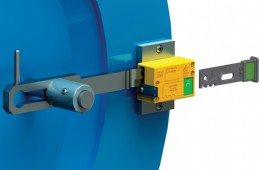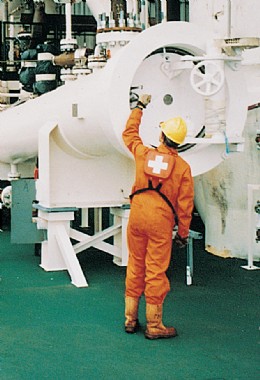The Case for Interlocking Pig Launchers and Receivers
By Mike Fynes, Sales and Marketing Director, Smith Flow Control

Diagram of a typical pig trap, using a Smith Flow Control interlock system in yellow.

A typical Smith Flow Control door lock fixed on a pig trap closure. The key (on the right) is inserted into the interlock to release the lock and allow the operator to open the door and load/retrieve the pig safely after all previous steps have been completed.

Operating a pig trap

Written safety procedures are not enough to ensure operator safety. Mechanical key safety interlocking is the only technology that can ensure that safety standards are met by removing human error. Interlocks will not allow the pig trap door to be opened unless it is depressurised and safe to do so.
Smith Flow Control (SFC) specifically developed a coded-card key interlock system to ensure the total isolation of pig trap vessels. These key interlocks mechanically prove their ‘closed and isolated’ status that enables venting and draining of pig trap vessels before loading or unloading operations. These principles have been widely adopted by UK pipeline regulators, Operating Companies and integrated into international standards such as API (American Petrochemical Institute) and ASME (American Society of Mechanical Engineers).
Key interlocks regulate the entire process by releasing and trapping keys in a predetermined sequence. Operating the unlocked equipment immediately traps the initial (i.e. inserted) key; when the operation is complete, a secondary (previously trapped) key may then be released thereby locking the equipment in the new position. This secondary key will be coded in common with the next lock (item of equipment) in the sequence. By this simple coded key transfer principle a ‘mechanical logic’ system is created which denies any scope for operator error.
Pig Loading
SFC interlocks can be customised depending on the application but in a basic scenario there are a few simple steps to launch a pig safely using interlocks. Each step traps a key and releases a key and keys are only released in order.
Keys are used to unlock and open the vent and drain valve respectively. These actions release a key that can then be used to open the vessel door safely and load the pig.
Once the pig is loaded and the vessel door is closed and locked, a key is released to close the drain and vent. This action releases the key that opens the kicker valve and launches the pig.
Once the pig is launched, the trap is re-isolated by closing and locking the mainline valve. This releases a sequence of keys that depressurises the trap by closing the kicker and opening the vent and drain. The final steps involve closing all valves; the final key is returned to the control room key cabinet where is it kept until the process starts again. No steps can be by-passed in this sequence, nor can steps be taken out of order.
System start condition:
• All valves are closed and locked closed.
• Vessel door closed and locked closed.
• Key 1 is located in the Control Room Key Cabinet.
1. To load pig(s)
A. Insert Key 1 into V1, unlock and open, lock open by releasing key 2.
B. Key 2 into V2, unlock and open, lock open by releasing key 3.
C. Key 3 into door lock. Unlock and open the vessel door, key 3 is retained all the time the door is unlocked and/or opened. *Load Pigs*
2. To isolate, pressurise then launch.
D. Close and lock closed the vessel door, key 3 is released.
E. Key 3 into V2, unlock and close, lock closed by releasing Key 2.
F. Key 2 into V1, unlock and close, lock closed by releasing Key 1.
G. Key into V3, unlock and open, lock open by releasing key 4.
H. Key 4 into V4, unlock and open. *Pig(s) Launched*
3. Re-isolate after launch
I. Close lock by releasing key 4.
J. Key 4 into V3, unlock and close, lock closed by releasing key 1.
4. Depressurise trap
K. Key 1 into V1, unlock and open, lock open by releasing key 2.
L. Key 2 into V2, unlock and open, lock open by releasing key 3.
M. Key 3 into V2, unlock and close, lock closed by releasing key 2.
N. Key 2 into V1, unlock and close, lock closed by releasing key 1.
5. Back to ‘dormant/start’ condition
O. Key 1 is returned to the Control Room Key Cabinet. *Proposed Sequence Ends* Interlocks do not reduce productivity. The key transfer system is integrated with the operation to create a seamless sequence of events that ensures safety and peace of mind.
SFC’s valve interlocks are mechanical. They do not rely on a power supply. They can be fitted to motorised valves without compromising the valve’s function and failsafe features. As a result, key interlocks provide independent control over the working of manually operated valves, end closures and motorised valves. In practice, this simple concept saves lives and protects plant and personnel during pigging operations worldwide.
Smith Flow Control (www. smithflowcontrol.com) is a leading supplier of valve interlocking systems for the oil and gas and chemical processing industries worldwide. SFC was established in 1985, and by 1990 became the generic term for key interlock safety systems in the international Oil & Gas industry; its client base now includes most of the major operating companies in all five continents. SFC offers bespoke solutions to customers with specialised requirements and in 25 years Smith Flow Control has never failed to provide a viable technical solution to a client’s safety operating problem.
Smith Flow Control Ltd
Tel: +44 (0) 1376 517901
www.smithflowcontrol.com
Published: 3rd December 2012
Rachel Wormald, Managing Director at YPS Valves Ltd and Elizabeth Waterman, ...
Are you looking for industry-leading, brand independent valve and actuator ...
As can be seen from the photograph, clearly the resident birds at Bartlett ...
Howco Group has unveiled its latest £1million investment, with the ...
In 2024, Allvalves is poised for an exciting year of growth and expansion, ...
GMM Pfaudler Engineered Plastics & Gaskets are delighted to bring the ...
In the ever-evolving valve industry, GMM Pfaudler stands out for its ...
SAMSON Controls Ltd – part of the SAMSON group - a renowned leader in ...










